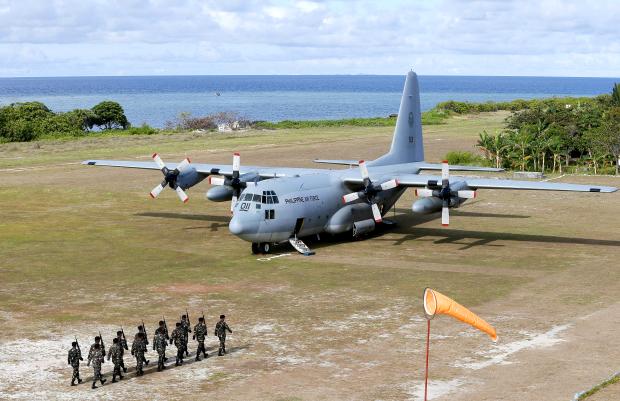China protests PH defense chief’s Pag-asa Island visit

Philippine troops march as a Philippine Air Force C-130 transport plane carrying Defense Secretary Delfin Lorenzana, Armed Forces Chief Gen. Eduardo Año and other officials, sits on the tarmac at the Philippine-claimed Pag-asa (Thitu) Island off the disputed Spratlys chain of islands in the South China Sea Friday, April 21, 2017 in western Philippines. Their visit Friday was aimed to assert the country’s claim to the heartland of a disputed area where China is believed to have added missiles on man-made islands. The South China Sea issue is expected to be discussed in the 20th ASEAN Summit of Leaders next week. Seen in the background above the horizon (center) is the Chinese man-made island of Subi Reef. (Photo by BULLIT MARQUEZ / AP)
Updated: 10:12 p.m., April 22, 2017
China has protested the visit by Manila’s defense and military chiefs to a Pag-Asa, or Thitu, Island, a disputed area in the South China Sea. But the Philippine government maintains it owns the territory where Filipino troops and villagers have lived for decades.
The public argument comes amid a thaw in once-frosty relations between the neighbors after President Rodrigo Duterte took office last June and moved to rekindle Manila’s friendship with Beijing, which has been strained by the long-seething territorial disputes.
Defense Secretary Delfin Lorenzana and Gen. Eduardo Año, chief of the Armed Forces of the Philippines (AFP), flew to Pag-asa Island with dozens of journalists Friday to inspect an eroded airstrip, which the government plans to reinforce and lengthen. They also met Filipino troops and villagers and took part in a flag-raising ceremony.
About P1.6 billion ($32 million) has been earmarked for the construction, including a fish port, solar power, water desalination plant, improved housing for soldiers, and facilities for marine research and tourists.
Article continues after this advertisementAccompanied by military top brass, Lorenzana and Año also met Filipino troops and villagers and took part in a flag-raising ceremony on Pag-asa, which is internationally known as Thitu and is called Zhongye Dao by China. It’s the second-largest island in the South China Sea’s hotly contested Spratlys archipelago.
Article continues after this advertisement[ventuno id=’OTI1MDQzfHwyMzY4fHwxMDg2fHwxLDIsMQ==’][/ventuno]
High profile visits
In Beijing, Foreign Ministry spokesman Lu Kang expressed China’s displeasure over the high-profile Philippine visits to the island, saying China was “gravely concerned about and dissatisfied” by the island visits and adding that China “has lodged representations with the Philippine side.”
“We hope that the Philippine side could cherish the hard-won sound momentum of development the bilateral relations are experiencing, faithfully follow the consensus reached between the two leaderships, maintain general peace and stability in the South China Sea,” he said.
The Philippine government replied by saying the island was part of an island municipality under its western province of Palawan, which faces the disputed waters.
“Our visits there are part of the government mandate to ensure the safety, well being, livelihood and personal security of our citizens there,” Department of Foreign Affairs spokesman Robespierre Bolivar said in a statement in Manila.
[ventuno id=’OTI0OTM1fHwyMzY4fHwxMDg2fHwxLDIsMQ==’][/ventuno]
Chinese warning
During the trip to Pag-asa, Chinese forces tried to drive away two Philippine Air Force planes that carried Lorenzana, Año and others as they flew near a Chinese man-made island called Subi, just 25 kilometers (15 miles) away.
Lorenzana said their aircraft continued uninterrupted without any incident after Filipino pilots messaged back to the Chinese that they were flying over Philippine territory. The Chinese warned the Philippine aircraft they were entering the periphery of Chinese installations and told to avoid miscalculation.
The Chinese navy has similarly warned US ships and aircraft to leave what Beijing claims as its territory, messages which the Americans also ignored.
China claims virtually the entire sea and has aggressively tried to fortify its foothold by transforming in recent years seven mostly submerged reefs into island outposts, including Subi. Three of the artificial islands were built with runways, along with buildings, towers, radars and more recently weapons systems, to the consternation of other Asian claimant governments and the United States, which insists on freedom of navigation in international waters.
For comprehensive coverage, in-depth analysis, visit our special page for West Philippine Sea updates. Stay informed with articles, videos, and expert opinions.